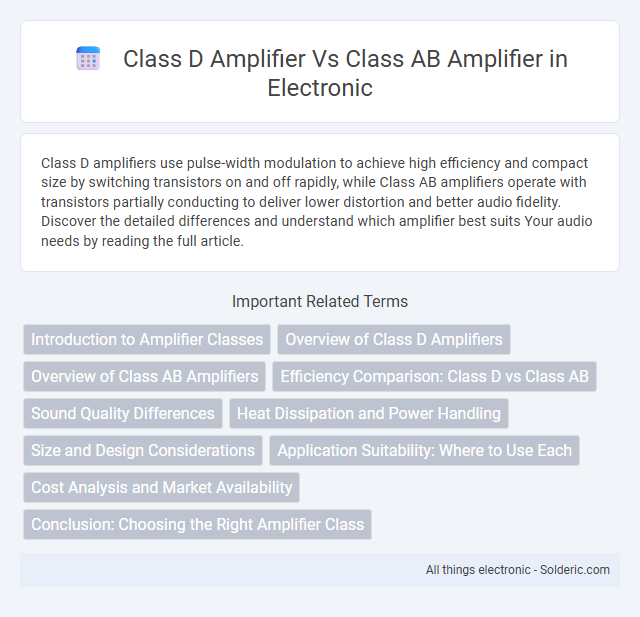Class D amplifiers use pulse-width modulation to achieve high efficiency and compact size by switching transistors on and off rapidly, while Class AB amplifiers operate with transistors partially conducting to deliver lower distortion and better audio fidelity. Discover the detailed differences and understand which amplifier best suits Your audio needs by reading the full article.
Comparison Table
| Feature | Class D Amplifier | Class AB Amplifier |
|---|---|---|
| Efficiency | High (80-95%) | Moderate (50-70%) |
| Heat Generation | Low | Moderate to High |
| Sound Quality | Good, but potential high-frequency noise | High fidelity, warmer sound |
| Size and Weight | Compact and lightweight | Bulkier due to heat sinks |
| Cost | Generally lower for same power output | Higher due to complex design and components |
| Application | Portable devices, subwoofers, high-power systems | Hi-fi audio systems, musical instruments, professional audio |
| Distortion | Higher distortion at low frequencies | Lower distortion, better linearity |
Introduction to Amplifier Classes
Class D amplifiers operate using pulse-width modulation and switching techniques, resulting in high efficiency often exceeding 90%, making them ideal for portable and battery-powered devices. Class AB amplifiers combine the low distortion of class A operation with the improved efficiency of class B, producing moderate efficiency around 50-70% and maintaining linear amplification for high-fidelity audio. Each amplifier class uniquely balances power efficiency, signal linearity, and heat dissipation, influencing their applications in audio amplification and electronic devices.
Overview of Class D Amplifiers
Class D amplifiers utilize pulse-width modulation (PWM) or pulse-density modulation (PDM) to convert analog signals into high-frequency digital pulses, resulting in significantly higher efficiency compared to Class AB amplifiers. This topology minimizes heat dissipation by operating output transistors as switches rather than linear gain devices, enabling compact designs and extended battery life in portable audio equipment. Class D amplifiers achieve efficiency levels often exceeding 90%, outperforming Class AB amplifiers that typically operate around 50-70% efficiency, making them ideal for power-sensitive applications.
Overview of Class AB Amplifiers
Class AB amplifiers combine the linearity of Class A with the efficiency of Class B, providing moderate power efficiency and low distortion in audio applications. They operate by biasing output transistors slightly on at all times, minimizing crossover distortion while maintaining sound quality. Your audio system benefits from Class AB's balanced performance, making it ideal for high-fidelity sound reproduction.
Efficiency Comparison: Class D vs Class AB
Class D amplifiers achieve efficiency levels above 90% by using pulse-width modulation and switching transistors that minimize power loss, whereas Class AB amplifiers typically operate at 50-70% efficiency due to continuous conduction in their output transistors. This significant efficiency advantage of Class D amplifiers results in reduced heat generation, smaller heat sinks, and longer battery life for portable audio devices. When optimizing your audio system for energy savings and thermal management, choosing a Class D amplifier provides superior performance over Class AB designs.
Sound Quality Differences
Class D amplifiers excel in energy efficiency but often introduce more harmonic distortion and noise, potentially affecting sound clarity compared to Class AB amplifiers. Class AB amplifiers provide superior linearity and lower total harmonic distortion (THD), resulting in more accurate and warmer sound reproduction preferred in high-fidelity audio systems. Audiophiles typically favor Class AB amplifiers for their better transient response and reduced crossover distortion, enhancing overall listening experience.
Heat Dissipation and Power Handling
Class D amplifiers generate significantly less heat due to their high efficiency, often exceeding 90%, making them ideal for applications where heat dissipation and power handling are critical. Class AB amplifiers operate with lower efficiency, typically ranging from 50% to 70%, resulting in more heat production and requiring larger heat sinks to manage thermal buildup. You can achieve higher power output and compact design with Class D amplifiers, especially when managing thermal constraints is a priority.
Size and Design Considerations
Class D amplifiers offer a compact size and lightweight design due to their high efficiency, enabling smaller heat sinks and fewer cooling requirements compared to Class AB amplifiers. Class AB models, while providing excellent sound quality, are bulkier and heavier because of larger heat dissipation components integrated into their design. Selecting a Class D amplifier benefits your setup when space-saving and energy efficiency are critical design considerations.
Application Suitability: Where to Use Each
Class D amplifiers excel in energy-efficient applications such as portable audio devices, car audio systems, and subwoofers due to their high power efficiency and compact size. Class AB amplifiers are preferred in home audio systems, high-fidelity sound equipment, and professional audio settings where sound quality and linearity are critical. Selecting between the two depends on whether efficiency or sound fidelity is the priority in the intended use case.
Cost Analysis and Market Availability
Class D amplifiers offer a cost-effective solution with lower production expenses due to simpler circuitry and higher energy efficiency, making them widely available in budget-friendly audio markets. In contrast, Class AB amplifiers generally incur higher manufacturing costs because of their complex design and greater power consumption, resulting in limited availability primarily in mid-to-high-end audio equipment. Market analysis reveals Class D amplifiers dominate in portable and consumer electronics, while Class AB retains a niche in audiophile and professional audio segments.
Conclusion: Choosing the Right Amplifier Class
Class D amplifiers offer superior energy efficiency and compact size, making them ideal for applications requiring low power consumption and minimal heat dissipation. Class AB amplifiers provide higher audio fidelity with lower distortion, preferred in high-end audio equipment emphasizing sound quality. Selecting the right amplifier class depends on balancing the need for power efficiency against audio performance requirements.
class D amplifier vs class AB amplifier Infographic

 solderic.com
solderic.com